.
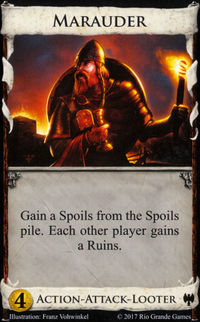 | #47 ▼19 Marauder (Dark Ages) Weighted Average: 54.6% ▼10.6pp / Unweighted Average: 58.2% / Median: 59.6% ▼5.8pp / Standard Deviation: 20.5%
Marauder takes a big drop this year, losing 19 ranks and over 10pp! While Marauder is close to essential when there is no convenient way to trash Ruins, it's a dubious pickup otherwise. The Spoils are nice, but slow.
|
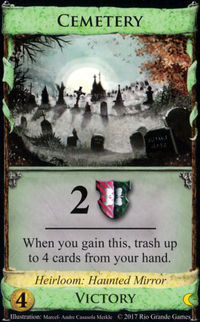 | #46 ▲2 Cemetery (Nocturne) Weighted Average: 55.9% ▲3.5pp / Unweighted Average: 54.9% / Median: 51.1% ▼0.8pp / Standard Deviation: 23.5%
Cemetery continues to hang out around the center of the list. Cemetery can be fantastically efficient trashing with a gainer like Workshop or (especially) Alms, but it's slow if you need to buy it. It's also easily gainable points, which occasionally matters.
|
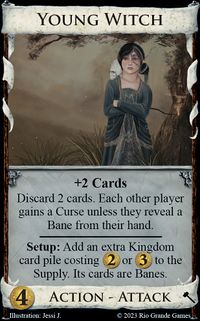 | #45 ▼16 Young Witch (Cornucopia) Weighted Average: 56.6% ▼8.3pp / Unweighted Average: 53.4% / Median: 56.4% ▼12.7pp / Standard Deviation: 23.4%
Young Witch has dropped a few years in a row, and this is the largest drop yet. Starting with Adventures and especially with the 2nd edition replacements, the Young Witch bane cards have been getting stronger and stronger, making it harder to justify investing in Young Witch. In games with either no Curse trashing or a weak bane, Young Witch can still play a role.
|
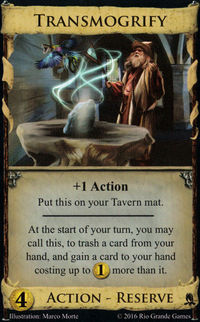 | #44 ▲3 Transmogrify (Adventures) Weighted Average: 56.7% ▲3.8pp / Unweighted Average: 52.5% / Median: 51.1% ▼2.0pp / Standard Deviation: 21.7%
Transmogrify rises a bit this year. Transmogrify is a flexible card that can turn Estates into Silver or something better, help ensure you kick off, and/or mill Provinces from the supply. Transmogrify is often a strong opener - especially if you find it on turn 3.
|
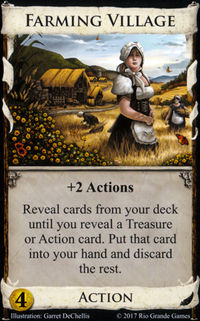 | #43 ▲3 Farming Village (Cornucopia) Weighted Average: 57.0% ▲0.4pp / Unweighted Average: 56.5% / Median: 53.2% ▼6.1pp / Standard Deviation: 15.7%
Next up in the many $4 villages is Farming Village. A $4 village is a pretty good card, and Farming Village has a minor effect added on which helps in situations where you can't trash Estates/Curses or in games with extended greening.
|
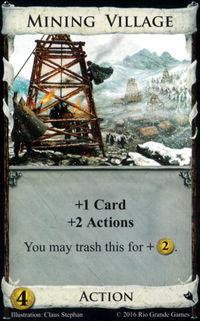 | #42 ▼5 Mining Village (Intrigue) Weighted Average: 57.5% ▼3.5pp / Unweighted Average: 55.2% / Median: 56.4% ▼5.3pp / Standard Deviation: 16.5%
Mining Village is up next, with a small drop. Opening Mining Village has rightly fallen out of fashion, but the ability to trash for coin is good for bursting on your last turn, and sometimes in combination with trash gainers (e.g. Lurker).
|
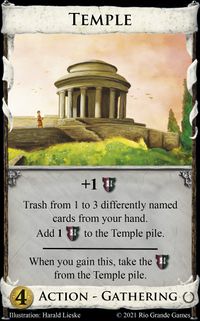 | #41 ▼2 Temple (Empires) Weighted Average: 58.7% ▼2.1pp / Unweighted Average: 57.0% / Median: 52.1% ▼7.9pp / Standard Deviation: 24.8%
After a moderate drop last year, Temple is beginning to stabilize. I know I thought Temple might be top card quality when it was first revealed, but with experience, many have realized that Temple is often too slow for a trasher that provides no material benefits. Still, sometimes you can build despite the reduced economy from Temple (in which case it's correct to open) - or Temple is the only way to trash a certain type of card (in which case it's correct to get later). And in these cases, the VP on the Temple pile is likely to play a minor role later in the game.
|
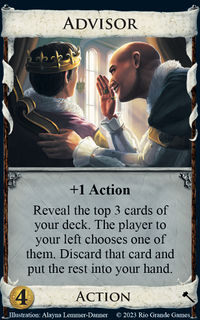 | #40 ▲1 Advisor (Guilds) Weighted Average: 60.1% ▲0.2pp / Unweighted Average: 58.1% / Median: 58.7% ▲4.4pp / Standard Deviation: 19.6%
Advisor stabilizes after a large jump last year. Non-terminal draw is strong, but Advisor can certainly be awkward. It shines brighest with gainers and supplemental draw (including cantrips) and in decks with consistent card quality. Other times, it gets outclassed by other draw.
|
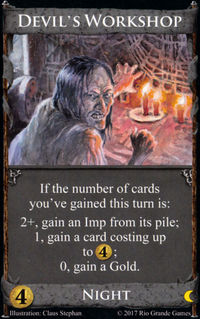 | #39 ▼6 Devil's Workshop (Nocturne) Weighted Average: 60.5% ▼2.3pp / Unweighted Average: 56.7% / Median: 55.3% ▼2.7pp / Standard Deviation: 19.7%
Devil's Workshop makes a surprise drop in the rankings this year. Devil's Workshop is very unique. While it's most common mode is that of a Night-phase Workshop, it also has powerful Gold-gaining and Imp-gaining modes. It can be difficult to gain Imps when Devil's Workshop is the only source of additional gains, which perhaps partly explains its fall.
|
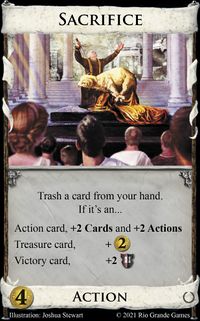 | #38 ▼4 Sacrifice (Empires) Weighted Average: 60.7% ▼1.5pp / Unweighted Average: 62.2% / Median: 63.8% ▼0.4pp / Standard Deviation: 21.1%
Sacrifice also makes a modest fall. Sacrifice is rated higher in the unweighted rankings, which perhaps heralds a fall in the future as well. Sacrifice is certainly better than no trashing at all, and it also works well to fill in gaps for specialized trashers. Sacrifice is top in class for dealing with Ruins, but its Copper-trashing and Estate-trashing modes are weaker than other options often present in the kingdom.
|
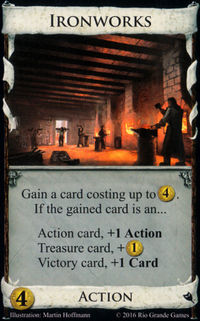 | #37 ▲5 Ironworks (Intrigue) Weighted Average: 60.7% ▲1.0pp / Unweighted Average: 58.3% / Median: 62.0% ▲5.1pp / Standard Deviation: 19.7%
Ironworks makes a modest rise. Ironworks specializes in gaining $3-$4 actions, can deplete piles rapidly with overdraw, and can power some VP rushes. For all that, there are kingdoms where the key cards all cost $5+ and Ironworks can't accomplish much.
|
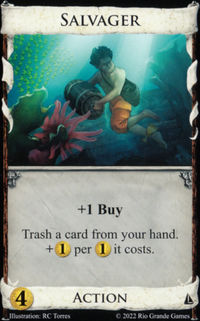 | #36 =0 Salvager (Seaside) Weighted Average: 60.9% ▼1.0pp / Unweighted Average: 60.0% / Median: 62.8% ▲1.1pp / Standard Deviation: 21.5%
Salvager retains its spot in the upper portion of the list. Salvager is great at trashing starting Estates and can trash Curses and Copper if necessary. Salvager can also trash cards that have overstayed their welcome, works well with Gold gainers, and can mill Provinces. Remodel also does most of these things, so I suppose Salvager is higher because people value its cosolation trashing of $0 cards.
|
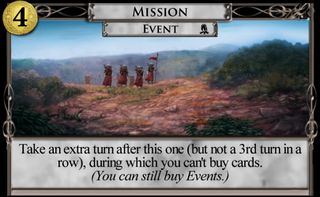 | #35 ▲15 Mission (Adventures) Weighted Average: 60.1% ▲9.8pp / Unweighted Average: 56.3% / Median: 55.3% ▲19.5pp / Standard Deviation: 26.2%
Mission makes a big rise this year, but retains a high standard deviation. Mission's value is highly board dependent, but it's strongest when there are ways to gain, attack, and trash on the Mission turn. Mission also plays nicely with the Page and Peasant lines.
|
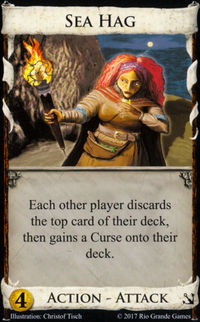 | #34 ▲4 Sea Hag (Seaside) Weighted Average: 61.8% ▲0.9pp / Unweighted Average: 61.7% / Median: 59.6% ▼3.4pp / Standard Deviation: 23.6%
Sea Hag makes a slight rise this year after a few years losing ranks. Once the top rated $4 card, there is still a lot of disagreement about Sea Hag's power level, as it received multiple votes in the top 10% and bottom 30%. Sea Hag is undoubtedly dominant in games with no way to trash Curses. But in games where it is convenient to trash Curses, the player who buys and plays Sea Hag might slow themselves down more than their opponent. Sea Hag is a brutal attack, and is sometimes valuable to cement a deck control advantage.
|
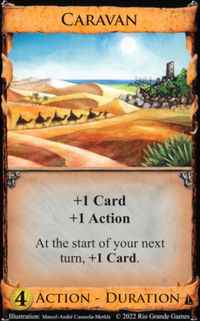 | #33 ▼7 Caravan (Seaside) Weighted Average: 62.1% ▼3.3pp / Unweighted Average: 62.5% / Median: 62.8% ▼5.1pp / Standard Deviation: 16.3%
Caravan's rank has oscillated a bit recently, while staying firmly in the upper portion of the list. Nonterminal draw is strong, but Caravan is pretty slow. Still, if it's the only draw, it's often worth getting. And it also adds consistency to decks with more efficient draw.
|
 | #32 ▲12 Envoy (Promos) Weighted Average: 63.4% ▲4.7pp / Unweighted Average: 60.9% / Median: 61.7% ▲6.1pp / Standard Deviation: 17.9%
Envoy makes a large jump this year (though only 4.7pp) to get closer to Smithy. Envoy is similar to Advisor in that it works best with supplemental draw and decks of consistent quality. Decks that rely on Envoy for draw can be quite inconsistent.
|
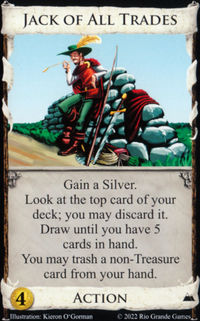 | #31 =0 Jack of All Trades (Hinterlands) Weighted Average: 63.9% ▼0.8pp / Unweighted Average: 65.9% / Median: 69.2% ▼7.1pp / Standard Deviation: 20.8%
After a big fall the past two years, Jack of All Trades is closer to stabilizing, though it is rated higher in the unweighted ranking. Jack of All Trades is a versatile proactive counter to most attacks. It can be the basis for a decently strong moneyish strategy, or it can be incorporated into an engine that can appreciate (or at least tolerate) the Silvers it provides.
|
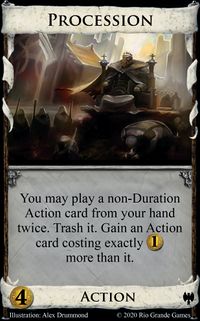 | #30 ▼3 Procession (Dark Ages) Weighted Average: 65.2% ▼0.2pp / Unweighted Average: 63.6% / Median: 68.1% ▲0.5pp / Standard Deviation: 22.6%
Procession falls ever so slightly after a larger rise last year, but retains a high standard deviation which includes a first place vote. Procession is one of the most challenging cards to play well. It offers a whole lot (throne effect + midturn upgrade), but in a total package that is often awkward (often you want to throne cards you can't upgrade into another action). Procession isn't gained nearly as often as its peers in this list, but how much of that is players being unsure how to incorporate the card?
|
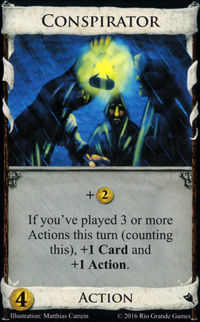 | #29 ▲3 Conspirator (Intrigue) Weighted Average: 65.9% ▲1.0pp / Unweighted Average: 64.1% / Median: 67.0% ▲0.3pp / Standard Deviation: 20.3%
Conspirator has remained pretty stable over the years. It's one of the most efficient sources of coin payload, but overinvesting reduces consistency. And, at the end of the day, pure coin payload can only contribute so much.
|
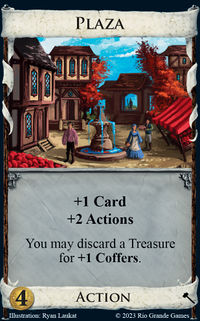 | #28 ▼7 Plaza (Guilds) Weighted Average: 66.1% ▼3.4pp / Unweighted Average: 61.5% / Median: 66.0% ▼3.1pp / Standard Deviation: 18.5%
Plaza falls a bit (and more significantly in the unweighted ranking), but still clearly separates itself from the weaker $4 villages. It's often worth picking up a Plaza even in the presence of other strong villages, because the flexibility of a few coffers is quite valuable. There are diminishing returns for Plaza's discard-for-coffers ability, but you'll be happy to keep gaining Plazas if you need the village effect.
|
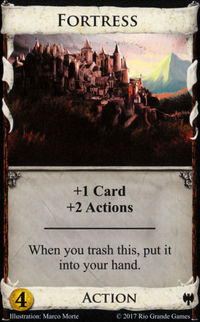 | #27 ▼5 Fortress (Dark Ages) Weighted Average: 67.2% ▼1.5pp / Unweighted Average: 65.4% / Median: 66.0% ▲0.6pp / Standard Deviation: 21.1%
Fortress also takes a small fall. Fortress's on-trash ability ranges from unusable to board-centralizing with trash for benefit (especially Procession and Develop), and its higher standard deviation reflects disagreement on how to evaluate that ability.
|
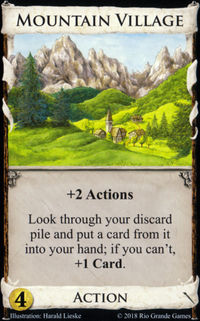 | #26 Mountain Village (Renaissance) Weighted Average: 67.2% / Unweighted Average: 66.6% / Median: 66.0% / Standard Deviation: 14.1%
We finally reach the next Renaissance card. Mountain Village has been initially placed with the other strong $4 villages - and with a lot of agreement. Mountain Village is best with mid-turn gaining and during the deck-building phase when there might be strong cards in the discard pile. It becomes worse than vanilla Village in the face of junking or discard attacks. Mountain Village is sometimes worth picking up in no-draw games even when the village effect is dubious, due to the value of selecting a card from the discard pile.
|
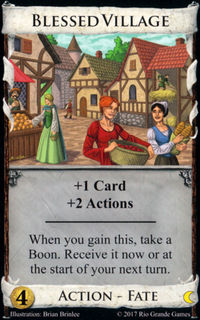 | #25 ▲6 Blessed Village (Nocturne) Weighted Average: 67.8% ▲3.3pp / Unweighted Average: 62.3% / Median: 67.0% ▼2.8pp / Standard Deviation: 18.8%
Blessed Village rises a little to top this group of villages. Blessed Village is deceptively strong; the choice of when to gain the boon offers a lot of flexibility, and being able to get a small advantage while adding a critical card to your deck speeds up building significantly. The unweighted average is lagging behind, which suggests that this card might continue to rise.
|
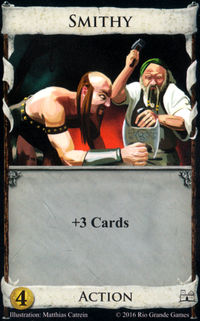 | #24 =0 Smithy (Base) Weighted Average: 68.5% ▲0.9pp / Unweighted Average: 65.8% / Median: 70.2% ▼3.9pp / Standard Deviation: 16.9%
Smithy maintains its place in the upper quartile with a lot of agreement. The price is right for Smithy, which offers strong terminal draw for only $4. It's best in the prescence of gainers and, of course, villages.
|
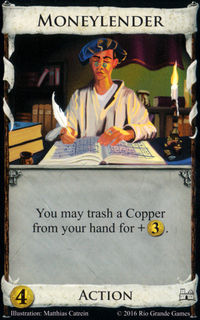 | #23 ▲11 Moneylender (Base) Weighted Average: 68.5% ▲6.5pp / Unweighted Average: 67.3% / Median: 72.3% ▲9.7pp / Standard Deviation: 14.5%
Moneylender makes a shockingly high rise in this year's rankings. Moneylender is a strong opener that lets you trash Copper and hit $5 at the same time. Perhaps Moneylender is looked upon more favorably now that there are many other cards that can fill in the gaps that Moneylender can't cover (trashing Estates and Curses).
|
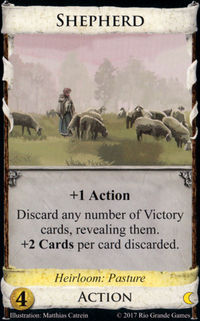 | #22 ▲1 Shepherd (Nocturne) Weighted Average: 69.0% ▲1.4pp / Unweighted Average: 68.1% / Median: 71.3% ▲2.2pp / Standard Deviation: 22.5%
Shepherd retains its position near the top, showing that it isn't a fad. Decks with Shepherd as the primary draw are quite unique, and can be very strong with Copper trashing and a little extra reliability.
|
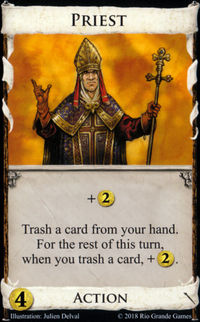 | #21 Priest (Renaissance) Weighted Average: 70.1% / Unweighted Average: 68.5% / Median: 71.1% / Standard Deviation: 23.1%
The next Renaissance card clocks in just outside the top 20. Like Salvager, you can open Priest and hit $5 while trashing Estates. Unlike Salvager, Priest can continue to trash $0 cards for decent benefit. Priest also has a payload ability that is hard to utilize in practice. This card has a lot of disagreement right now, with several votes in the top 10% and the bottom 50%.
|
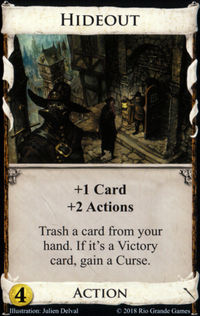 | #20 Hideout (Renaissance) Weighted Average: 70.6% / Unweighted Average: 68.6% / Median: 73.4% / Standard Deviation: 18.5%
Another Renaissance trasher makes its appearance. Hideout is a rare trasher that is weaker in the opening. It works best as supplemental trashing (Curses or Copper, ideally) and supplemental +actions. As the only source of trashing or +actions, it is awkward but often worth it.
|
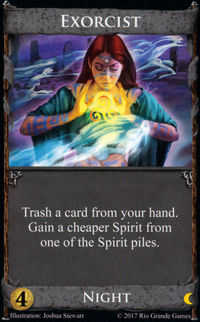 | #19 ▲18 Exorcist (Nocturne) Weighted Average: 70.8% ▲10.3pp / Unweighted Average: 66.0% / Median: 64.9% ▲8.1pp / Standard Deviation: 22.1%
Exorcist is one of the big winners in this list, gaining 18 ranks and 10.3pp! It still has a lot of disagreement with several votes in the bottom half and a first place vote. Exorcist is great at non-terminally turning Estates into Will-o-Wisps. It can also trash Curses and Copper if necessary, or trash more expensive cards (that have either overstayed their welcome or were efficiently gained) into Imps or Ghosts.
|
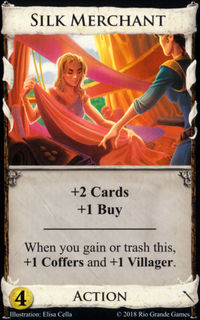 | #18 Silk Merchant (Renaissance) Weighted Average: 71.1% / Unweighted Average: 66.5% / Median: 66.0% / Standard Deviation: 25.2%
The next Renaissance card, Silk Merchant, makes it into the top 20. Silk Merchant is a deceptively strong card that is especially powerful to open with - and with trash for benefit. Silk Merchant has a lot of disagreement right now, with stronger players pushing the average upwards. I fully expect Silk Merchant to rise next year as people get familiar with how strong it is.
|
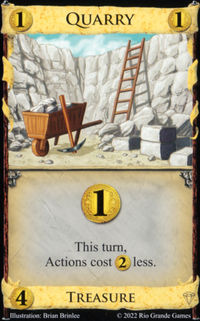 | #17 ▲2 Quarry (Prosperity) Weighted Average: 71.4% ▲3.2pp / Unweighted Average: 70.8% / Median: 75.0% ▲8.3pp / Standard Deviation: 18.1%
Quarry makes a slight rise this year. Quarry is especially strong in the presence of +buy, where its cost reduction can be applied multiple times. In games without +buy, it's hard to get excited about a restrictive Gold.
|
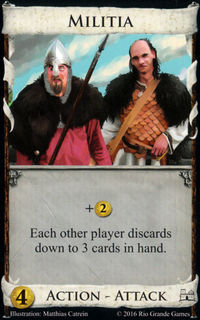 | #16 =0 Militia (Base) Weighted Average: 73.1% ▼1.2pp / Unweighted Average: 73.5% / Median: 77.7% ▼0.1pp / Standard Deviation: 19.2%
Militia stands the test of time and retains its high placement. Handsize attacks are almost always worth getting at some point in the game, and Militia distinguishes itself from the competition by costing only $4.
|
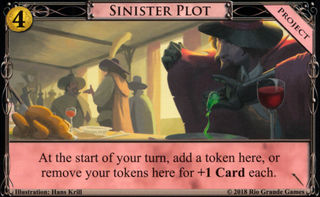 | #15 Sinister Plot (Renaissance) Weighted Average: 74.4% / Unweighted Average: 73.5% / Median: 71.7% / Standard Deviation: 20.0%
Sinister Plot sneaks into the 15th slot with relatively high agreement (for a Renaissance card). Sinister Plot is almost always worth picking up at some point, and the sooner the better (usually). Sinister Plot can help spike a higher pricepoint early, save a dud turn, and/or set up a megaturn. Very handy.
|
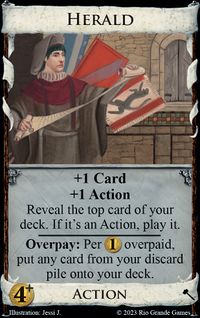 | #14 ▼1 Herald (Guilds) Weighted Average: 75.6% ▼1.1pp / Unweighted Average: 73.5% / Median: 79.8% ▲0.8pp / Standard Deviation: 21.6%
After a fall last year, Herald has started to stabilize. Herald can provide +actions and +cards all at the same time. All you need is a deck with a high action density. Herald is best when it can be efficiently gained in bulk and when you can trash your starting cards. Herald's forced play is occasionally awkward with mandatory trashers or decks where play order must be carefully controlled. Sometimes, you can build more reliably without Herald.
|
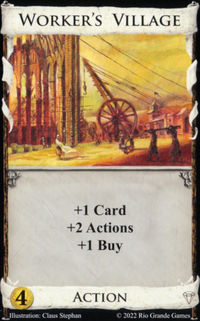 | #13 ▼1 Worker's Village (Prosperity) Weighted Average: 75.8% ▼2.2pp / Unweighted Average: 72.6% / Median: 77.7% ▼2.7pp / Standard Deviation: 19.0%
Worker's Village can't quite crack the top 10. Worker's Village looks so unassuming, but getting +buy with your +actions is a huge boon to building an engine. With the plentiful +buy that a stack of Worker's Villages provide, 3-pile endings become far more likely.
|
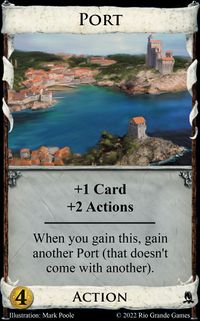 | #12 ▼1 Port (Adventures) Weighted Average: 77.4% ▼1.9pp / Unweighted Average: 73.1% / Median: 83.0% ▼1.0pp / Standard Deviation: 22.7%
Port retains its spot just above Worker's Village and Herald. Getting two Ports for one buy is very efficient. Port is especially good with Adventures tokens, but works less well with gainers.
|
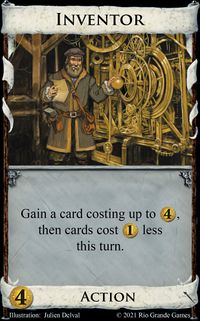 | #11 Inventor (Renaissance) Weighted Average: 79.8% / Unweighted Average: 78.2% / Median: 87.2% / Standard Deviation: 21.8%
Inventor is the highest rated $4 Renaissance card this year, landing just short of the top 10. Inventor's cost reduction is definitely the strongest bonus effect of the $4 workshops, but there is some disagreement as to how it compares with strongest $4 cards, including Bridge. Like Bridge, Inventor gets stronger in multiples - so long as you have the +actions and draw to support them.
|
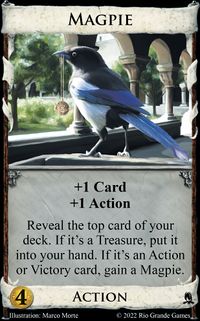 | #10 ▲3 Magpie (Adventures) Weighted Average: 81.8% ▲6.4pp / Unweighted Average: 79.5% / Median: 87.2% ▲4.5pp / Standard Deviation: 19.2%
Magpie rebounds into the top 10 this year. A single Magpie is quite innocuous, but leaving the opponent to gain 7+ Magpies efficiently is often a losing move. Magpie is especially good in decks with a treasure payload, with Adventures tokens, and with trash for benefit.
|
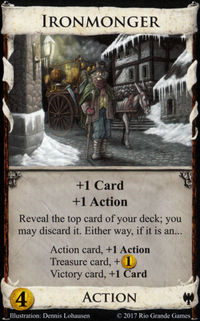 | #9 ▼4 Ironmonger (Dark Ages) Weighted Average: 82.5% ▼5.1pp / Unweighted Average: 79.9% / Median: 86.2% ▼2.7pp / Standard Deviation: 21.9%
Ironmonger drop a few places this year, but holds onto a top 10 spot. Ironmonger is a fantastic opener, and stays strong throughout the game and in any deck. As the only source of +actions, it's not ideal, but still worth going for. It gets stronger in games with sustained greening.
|
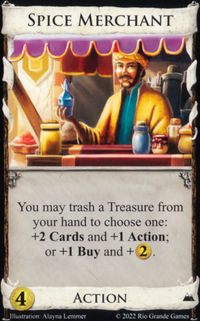 | #8 =0 Spice Merchant (Hinterlands) Weighted Average: 82.7% ▼2.8pp / Unweighted Average: 76.4% / Median: 85.1% ▼3.1pp / Standard Deviation: 20.6%
After last year's rise, Spice Merchant retains its place. Spice Merchant is one of the most efficient Copper trashers in the game, and an excellent opener. Spice Merchant is also occasionally the only source of +buy, which is awkward but can be made to work with a treasure gainer.
|
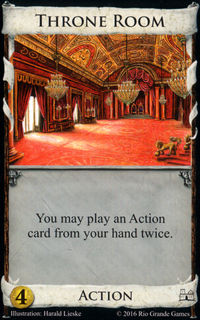 | #7 ▲2 Throne Room (Base) Weighted Average: 83.7% ▲2.5pp / Unweighted Average: 81.3% / Median: 87.2% ▲0.8pp / Standard Deviation: 18.0%
Throne Room makes a small jump into 7th place. Throne Room is powerful and flexible, amplifying your draw or payload as needed - all the while saving on +actions. Throne Room is at its best with efficient gainers and terminal draw. It's weaker when decks are unreliable or payload isn't throneable (e.g. treasures or Bridge Troll).
|
 | #6 ▼2 Sauna (Promo) Weighted Average: 85.1% ▼4.2pp / Unweighted Average: 87.1% / Median: 90.4% ▼1.0pp / Standard Deviation: 12.2%
Sauna makes a small drop after last year's high initial placement. It's even higher in the unweighted rankings, suggesting that weaker players overestimate its strength. Sauna does have a high amount of agreement, with no votes in the bottom half (which no other card comes close to)! Sauna + Silver is a decent way to trash; weaker in the beginning, but ramping up in the midgame. Sauna + Avanto is also a very efficient source of draw. It can be awkward, however, to get to Avantos if you're the only player getting Saunas - so if there is other trashing and +actions, avoiding Sauna can be correct.
|
 | #5 ▲2 Villa (Empires) Weighted Average: 87.2% ▲0.3pp / Unweighted Average: 84.1% / Median: 90.4% ▲2.7pp / Standard Deviation: 17.5%
Villa bumps up into the top 5. If Villa is the only source of +actions or +buys, it's an essential pickup. But Villa's true strength lies in how it lets you build in a different way: loading up on terminal draw and payload and getting Villas as needed to keep going. Villa has additional synergies with cards that benefit from emptying your hand of treasures before playing (e.g. Library). And while these decks can fall apart when Villas run out, leaving all 10 Villas to the opponent is a sure way to lose. Villas are also bonkers with cost reduction or other pile-emptying enablers (e.g. Haggler, Talisman) - leading to very quick pileouts. Villa is a truly game-changing card.
|
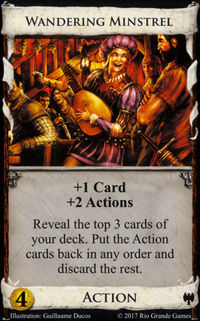 | #4 ▼1 Wandering Minstrel (Dark Ages) Weighted Average: 89.3% ▼0.4pp / Unweighted Average: 84.3% / Median: 91.5% ▼2.3pp / Standard Deviation: 21.8%
Wandering Minstrel retains its place near the top. The most highly esteemed of the $4 villages, Wandering Minstrel accelerates your deck towards the cards you most want to play. Wandering Minstrel also lets you re-order your actions, which provides additional synergy with some cards (e.g. Vassal). Wandering Minstrel's filtering is so strong that it often allows engines to overcome a bunch of junk cards.
|
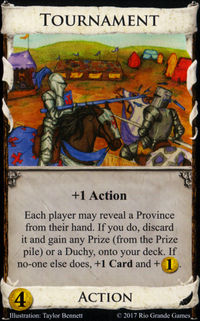 | #3 ▼1 Tournament (Cornucopia) Weighted Average: 90.9% ▼0.8pp / Unweighted Average: 88.2% / Median: 93.6% ▼2.7pp / Standard Deviation: 18.0%
Tournament loses a position, but has 5 first place votes. Tournament's prizes are very strong cards; it's often essential to build around gaining them. Tournament acts like a Poacher in the early game, which makes it convenient to incorporate into a build. Tournament is at its strongest when the Prizes fill a gap in the kingdom; Followers for a handsize attack, Trusty Steed for +actions, Princess for +buy, Followers and Trusty Steed for +cards.
|
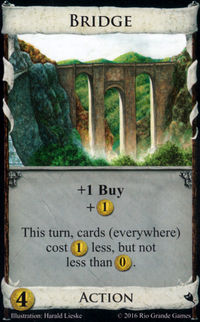 | #2 ▲4 Bridge (Intrigue) Weighted Average: 91.4% ▲4.0pp / Unweighted Average: 87.6% / Median: 93.6% ▲3.5pp / Standard Deviation: 18.2%
Bridge continues its climb into 2nd place! Bridge received two first place votes. Bridge is one of the strongest payload cards in the game. Playing 7+ Bridges lets you immediately empty the Province pile, and many Bridge games revolve around being the first person to do so, while dancing around 3-pile endings that Bridge empowers. Bridge is also a decent opener, often helping to gain the components needed to fuel the megaturn. Bridge is much weaker in kingdoms that lack +actions or sufficient draw.
|
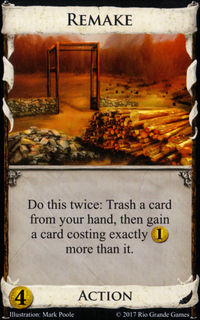 | #1 =0 Remake (Cornucopia) Weighted Average: 95.4% ▲1.2pp / Unweighted Average: 90.0% / Median: 97.9% ▼0.4pp / Standard Deviation: 21.7%
Remake keeps its first place spot and shows no signs of giving it up. Remake has a clear lead over the other top 5 cards and received 13 first place votes. Remake is a very strong opener. Turning Estates into Silver or better is good for tempo. When trashing two Copper is considered a card's weaker mode, you know you have a strong card. Remake can also be a powerful gainer later in the game, but it's often awkward in forcing you to upgrade exactly two cards.
|




 purchase to pay off. And sometimes there's no draw and Fortune is pretty weak.
purchase to pay off. And sometimes there's no draw and Fortune is pretty weak.















































 card +
card +  card sometimes.
card sometimes.
 and produces
and produces  would be super strong. Copper and 2 Poor Houses is a Province, no matter what else is in your hand.
would be super strong. Copper and 2 Poor Houses is a Province, no matter what else is in your hand.